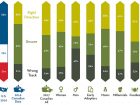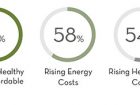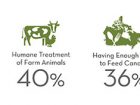
Canadians weigh in on food system
By Crystal Mackay
Features Business & Policy Consumer Issues annex Business/Policy Canada Consumer relations Research Specialty ResearchHighlights from the 2017 Canadian Centre for Food Integrity Public Trust Research.
Begin with the end in mind. This simple leadership mantra captures the essence of the Canadian Centre for Food Integrity (CCFI) research on understanding Canadians’ expectations regarding trust and transparency in our food and how it’s produced. Before investing millions in changing farm and food production practices or in efforts to communicate with the public, it’s important to have a solid understanding of public perceptions and concerns. To be most effective, this investment should be part of a long-term game plan with proactive, collaborative thinking.
The 2017 CCFI Public Trust Research builds on the benchmark data collected in 2016. It includes trend data from previous waves of our predecessors’ Canadian Farm Issues Studies dating back to 2002. It also incorporates the extensive Consumer Trust research undertaken by The Center for Food Integrity in the U.S. since 2007.
Last year, CCFI tested the peer-reviewed and published public trust model. It confirmed shared values are three to five times more effective at earning trust than facts. We also learned there are some serious disconnects between those responsible for important food system aspects, like food safety, and those who are trusted. For example, food companies and government ranked lowest for trust and competence on food safety by the public, yet they were held most responsible both for implementation in 2016 and transparency in 2017.
The 2017 CCFI research was chosen around transparency and how it works to earn trust. Is it possible to overcome negative bias and lack of trust with authentic transparency efforts? The U.S. CFI conducted similar work on transparency in 2015, which allows for valuable North American comparisons.
The 2017 web-based study was completed in May and June by 1,307 respondents who reflect the general Canadian consumer population. To provide deeper insights, we segmented the respondents into three groups: moms, millennials and foodies. We also made some extra effort with millennials with additional work to help answer some questions raised about our up and coming consumers from the 2016 research.
Thoughts on food and farming
Is the food system headed in the right direction? This big picture question helps set the basis for all the more specific research work that follows. Survey results show a significant increase in the number of consumers who feel the food system is heading in the right direction – 43 per cent in 2017 compared to just 30 per cent in 2016. This increase was consistent across all segments – male, female, moms, millennials and foodies.
There is also a significant decrease in the number of consumers who feel the food system is heading down the wrong track – only 14 per cent feel this is true compared to 21 per cent in 2016.
In figure 1, note the significant difference between American and Canadian results, the segments and men and women specifically. Think about how best to position your messages and messengers to communicate and connect more effectively in the future.
Putting life issues in perspective
Survey participants were asked to rate their level of concern on several life issues, including broad areas like health care costs, unemployment and food safety. This work is important at the beginning of the research to provide larger context for food system issues. The rising cost of food and keeping healthy food affordable maintained the top two positions again in 2017. The safety of food imported from outside of Canada made the top five in 2017, while the concern for the economy dropped to sixth.
What does this mean? If you work in the poultry sector, anywhere from a farm to a genetics company, you are in the business of providing healthy, affordable food for Canadians. Think about your messages and positioning of your work with the top concerns shown in figure 2 in mind.
When we looked at other food system issues, the level of concern drops somewhat (see figure 3). This doesn’t mean topics like animal welfare are not important to Canadians when we ask them about it directly. It just provides some valuable context in terms of priorities and levels of concern in the bigger picture.
Trend watch on hot topics
CCFI tracks consumer attitudes about food system issues over time. This tracking is valuable to determine trends and hot topics. It’s also a valuable tool to evaluate the effectiveness of our efforts to address and reduce the levels of concern. Once again, hormones, pesticides, drug residues and GMOs top the list of issues with the highest levels of concern (see figure 4 online). While 49 per cent feel they trust food produced in Canada more than outside Canada, only 33 per cent trusted the government food inspection system to ensure food safety.
What we learned and how to apply it
This research is uniquely designed to be actionable by anyone in the food system – from individual farmers to food retailers and everyone in between. The trend watching is meant to help shift thinking, resources and actions proactively. What’s really important to consumers versus what maybe inflamed in the news, social media or by critics with a specific cause?
- What you do is important – Rising cost of food and keeping healthy food affordable ranked as the top two concerns for the second year in a row over a long list of others including health care, energy and the economy. This is a really important factor when thinking about ways to most successfully engage with anyone, particularly those who don’t work in food or agriculture. How does what you do and discuss relate to keeping healthy food affordable?
- Reach the neutral zone – Almost half of our population is unsure about our food system. Concerns on issues such as antibiotics, pesticides and GMOs remained constant in 2017. Our collective existing efforts to move the bar on these topics haven’t reached the majority who are unsure yet. What can you do to engage on some new channels or with some new thinking to reach those who aren’t sure what to think?
- Share the love for Canadian foo – Foodies love to share information, more than any other segment – about food, nutrition, cooking and food safety. They also actively seek out information on all things food including specifics like how food processing affects food safety and how food is grown. Others go to them for information about food. The research shows foodies are more concerned about most food system issues than other segments, yet are also often more positive. This is a unique opportunity for those working to earn trust – foodies are engaged information seekers and sharers looking for authentic answers to everything food in Canada.
Visit www.foodintegrity.ca or contact CCFI for more detailed insights.
Crystal Mackay is president of the Canadian Centre for Food Integrity.
Print this page


